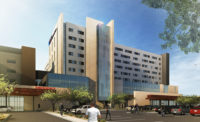After Maricopa County voters renewed the half-cent sales tax in 2004, "with all funds combined, [the county] has a $17.9-billion regional transportation plan, consisting of freeways, major arterials and transit," Halikowski says.
By being conservative and fiscally responsible, he says ADOT has been able to keep preconstruction of the South Mountain Freeway on schedule and has progressed with the widening projects of Loop 101 and Loop 202, despite the lingering effects of the economic downturn.
Slated to begin construction later this year, South Mountain Freeway incorporates years of research and studies.
"The project has been in the bag of the regional freeway program since 1985," says Rob Samour, senior deputy state engineer.
The 22-mile freeway connecting the east and west valleys will help alleviate congestion in downtown Phoenix, according to ADOT.
"A project like this required a federal environmental impact statement to be approved," he says. "We have been working with the federal highway administration on that. When we engaged into federal action, we went ahead and looked at many components of environmental concerns: air quality, any historical properties, wildlife, water quality, environmental justice and visual impacts."
Future Possibilities
The outlook for ADOT projects in Maricopa area and statewide is promising, Halikowski says. Plans include continued modernization of the state's 1970s-era interstates and beefing up economic connections to other states and regions.
"ADOT and the Maricopa Regional Association of Governments (MAG) have a 20-year plan based on the half-cent sales tax and other state and federal funds," he says. "That projection is based on projections the economic committees put forward. ADOT has a five-year transportation construction improvement program that is also fiscally constrained based on economic estimates of revenue available."
Projects in the planning stages for the next 20 years include State Route 30, a reliever to I-10 in the southwest corner of the Phoenix metropolitan area, and a future Interstate 11 that will run north-south from Mexico to Las Vegas.
"Other projects include the north-south corridor that would run out into Pinal County from roughly the Apache Junction area to Tucson, and as we look at the south half [of the Phoenix metro area] and the I-10, the Loop 303 interchange is going to be important as we look out to the future," Halikowski says. "Decisions on how those projects will be prioritized will fall to the regional council of MAG and also the state transportation board."
Trade and commerce also play a major role in the future planning of interstates in the state.
"We're especially interested in Mexico and the California since the Long Beach and Los Angeles ports are the gateway to the world for what we make here," he says. "The other piece is the I-11 corridor into Canada because the Canadians are our second-largest trade partner next to Mexico. We are seeing an increasing amount of Canadian investment and folks buying second houses in the Phoenix metro area and we certainly want to encourage those investments."







Post a comment to this article
Report Abusive Comment